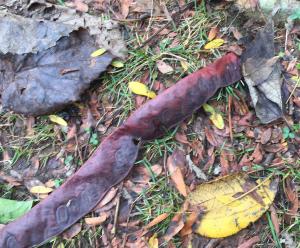This area is an old field that has not been farmed since the mid 1960s. During the intervening years, the process of ecological succession has slowly worked to repair the effects of farming – a disturbance – and return this area to woodland. The area on the left (east) side of the trail, however, underwent another disturbance during the mid 1980s when it was cleared of vegetation (but not soil) during the same highway construction that left the borrow pit where the prairie now stands. There, the process of secondary succession had to start anew. Look carefully at the progress of succession by comparing the area on the left – about 15 years post-disturbance – to the area on the right which is 40 years post-disturbance. What differences do you see?
During succession woody species, such as the brambles (berry bushes with canes) apparent to the left of the trail, and honey locust (Gleditsia tricanthos, with defensive spikes growing on the trunk), which are visible on the right side, take hold. Many early successional plants – thistles, brambles and the honey locust among them – succeed because they have thorns and stickers to prevent grazing. If you were to stop mowing your lawn for several decades, you would end up with many of these species in your yard!





